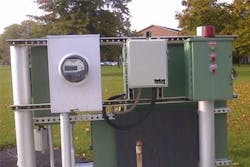Wireless Lift Station Monitoring Offers Real-Time Information
Lift stations are remote pumping facilities that move wastewater from lower to higher elevations. Monitoring lift stations is important for collection system operators to obtain real-time alarms on pump failures; wet well overflow; station tampering or vandalism; AC power failure; power failure; and excessive pump temperature and/or vibration. It also ensures pumps are functioning properly and sized correctly, optimizing energy efficiency, and tracks station flows.
A comprehensive lift station monitoring system provides information to operations, maintenance, collections, and modeling groups within a utility. This includes real-time alarming, time-stamp event data, trend data, station flow history, pump cycle data, pumping rate history, pump energy efficiency history and site diagnostics.
Telog offers an economical remote monitoring system for lift stations. The Telog system collects information on station operation and provides a combination of real-time alarms and historic data pump activity, pump performance, stations flows and station alarms. Information is shared with interested parties via Web server access; e-mail and/or SMS message alarms; daily, weekly and monthly reports; and data sharing with third party applications (modeling, SCADA, etc.).
Data is automatically collected from lift stations using Telog RTUs and then transferred via cellular to your choice of Telog’s Enterprise server platform or Telog cloud solution platform. Data may be transmitted on a user-defined schedule and/or immediately on detection of a station alarm.
Information can be viewed via a secure Web browser or stored for archival use in the Enterprise SQL database to share with other applications—such as SCADA, modeling and billing—and made available to users in report format or graphical presentations on a website.
